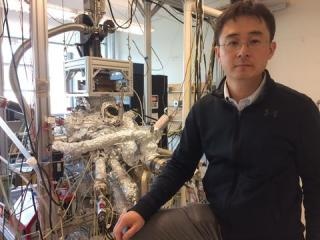Jul 1 2019
A collaborative team of researchers from the Massachusetts Institute of Technology and the University of California, Riverside (UCR) is getting closer to proving the existence of an unusual quantum particle known as Majorana fermion.
 Peng Wei is a condensed-matter physicist studying quantum states of electrons in new materials. ( Image credit: UCR/I. Pittalwala)
Peng Wei is a condensed-matter physicist studying quantum states of electrons in new materials. ( Image credit: UCR/I. Pittalwala)
This exotic quantum particle is important for fault-tolerant quantum computing—the type of quantum computing that deals with errors at the time of its operation.
Quantum phenomena are used by quantum computing to carry out computations. Majorana fermions dwell at the edge of unique superconductors referred to as topological superconductors, which have Majorana fermions outside at their boundaries and harbor a superconducting gap in their interiors.
One of the most popular objects in quantum physics is Majorana fermions because they are their own antiparticles and can divide the quantum state of an electron in half. In addition, they follow different statistics when compared to electrons. Many have claimed to have detected them, but researchers are yet to prove their extraordinary quantum nature.
The UCR-MIT group resolved this problem by creating a novel heterostructure, gold-based material system that can perhaps be used for showing the quantum nature and existence of Majorana fermions. Made up of layers of considerably different materials, heterostructure materials exhibit entirely different functionalities in comparison to their separate layers.
It is highly nontrivial to find a material system that is naturally a topological superconductor. A material needs to satisfy several stringent conditions to become a topological superconductor.
Peng Wei, Assistant Professor, Department of Physics and Astronomy, University of California, Riverside
Wei is also a condensed matter experimentalist at UCR, who co-headed the research, which was featured in Physical Review Letters, with Patrick Lee and Jagadeesh Moodera of MIT
Believed to be half of an electron, the Majorana fermion is anticipated to exist at the ends of a topological superconductor nanowire. Fascinatingly, two Majorana fermions can integrate with one another to constitute a single electron, thus enabling the electron’s quantum states to be stored non-locally—a benefit for fault-tolerant quantum computing.
Earlier in 2012, MIT theorists, headed by Lee, theorized that heterostructures of gold can turn out to be a topological superconductor under rigorous conditions. The UCR-MIT team performed experiments that were able to achieve all the required conditions for heterostructures of gold.
“Achieving such heterostructure is highly demanding because several material physics challenges needed to be addressed first,” stated Wei, a UCR alum who returned to campus in the year 2016 from MIT.
Wei further explained that the research paper demonstrates that magnetism, superconductivity, and the spin-orbit coupling of electrons can co-exist in gold—a rather complicated challenge to meet—and be physically combined with other kinds of materials via heterostructures.
“Superconductivity and magnetism ordinarily do not coexist in the same material,” he added.
Gold is not a superconductor, and so do the electron states on its surface, Wei explained.
“Our paper shows for the first time that superconductivity can be brought to the surface states of gold, requiring new physics,” he stated. “We show that it is possible to make the surface state of gold a superconductor, which has never been shown before.”
In addition, the study demonstrated how the electron density of superconductivity in the surface states of gold can be altered.
This is important for future manipulation of Majorana fermions, required for better quantum computing. Also, the surface state of gold is a two-dimensional system that is naturally scalable, meaning it allows the building of Majorana fermion circuits.
Peng Wei, Assistant Professor, Department of Physics and Astronomy, University of California, Riverside
In addition to Lee, Moodera, and Wei, the research group also includes Marius Eich and Sujit Manna of MIT.
The John Templeton Foundation, Office of Naval Research, National Science Foundation, and Department of Energy funded the study.